|
COLONIAL
A Study of Virginia Indians and Jamestone: The First Century |

|
CHAPTER 77:
A Seventeenth Century Chronology Drawn from Colonial Records with Contemporary Native Perspectives
Danielle Moretti-Langholtz and Angela L. Daniel
Introduction
For thousands of years, diverse native societies flourished on a continent later to be known as North America. In the late 16th and 17th centuries, the expansionist ideology of Europe brought change, upheaval and destruction to those indigenous societies. While the history of the colonial encounter has been told primarily from a non-native perspective, a careful examination of colonial documents and recorded history provides a glimpse of the impact of these events had on Native Peoples. These selected events are combined in this chapter with a time line produced from English records in the left column and contemporary Native commentary in the right column.
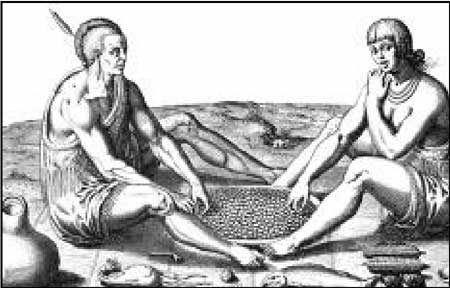
Detail of "Their sitting at meate," by Theodor
de Bry, 1590.
Native Voice
"Virtually all of the early attempts to establish colonies would have failed if the Indians had not assisted the white men from across the waters in obtaining food. The Indians were frequently described by the colonists, upon first contact as friendly and trusting. The encounters soon fell into an all familiar pattern: friendly curiosity, helpfulness and with growing experience, deepening distrust, fear and hostility.
In their attempts to establish a colony on Roanoke Island, the English destroyed what had begun as a friendly, helpful relationship. Sir Richard Grenville burned an Indian village over the alleged theft of a silver cup. Captain Ralph Lane, after receiving a friendly reception, attacked Chief Wingina due to a false allegation that Wingina was planning a large scale attack. Captain Lane's man servant caught and beheaded the wounded Chief Wingina. The English won the battle but lost the war. The "Lost colony" may have been the result."
— Oliver L. "Fish Hawk" Perry
Nansemond Chief Emeritus
September 16, 1989
"You have to start with the Spaniards."
— Kirk Moore
Pamunkey Tribal Member
March 8, 2004
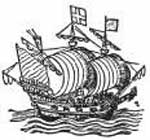
1606
November 20, 1606
King James I grants a charter to the Virginia Company of London,
authorizing its investors to establish a colony in
"Virginia."1
1607
Arrival of English in Tsenacomoco, which the English called "Virginia."2
April 26, 1607
Captain Newport's three ships, the Susan Constant, Godspeed, and
the Discovery, enter the Chesapeake Bay and land.3
April 30, 1607
Indians at the village of Kecoughtan (present-day Hampton Roads) welcome
the English after Captain Newport puts his hand on his heart, showing
they come in peace. Other villages, such as Paspahegh and Kiskiak also
extend hospitality.4
May 1607
The English sail up the Powhatan River, and rename it in honor of their
King James. They enter a peninsula-like projection of land in the
Paspahegh's country.5
Native Voice
"We welcomed the English. They would not have survived without our assistance."
— Chief Stephen Adkins
Chickahominy Tribe
March 4, 2004
"Why do you think the English built a fort? It was not to keep the Indians out, but to keep the Spaniards out."
— Keith Smith
Nansemond Tribal Member
March 4, 2004
"When the English settlers arrived at Jamestown in 1607, the Tidewater area of Virginia had been inhabited for thousands of years by Native Americans. There were many tribes with very specialized religions, life styles, customs and political structures. The tribes were not nomadic but were very settled with large areas of land cleared for agriculture. The Powhatan tribes were located along the waterways and had observed European ships entering the Chesapeake Bay to capture Indians for the slave trade since the mid-1500s. They had witnessed and experienced the deadly effects of cannons, muskets and hangings. T h e Indians provided the early settlers with food and taught them how to plant corn, to hunt and fish. The need for land and food supplies increased as more ships and many people continued to arrive and the settlement expanded rapidly. The foreign invaders forced the Indians off their ancestral homeland, confiscated their cleared fields, destroyed their longhouses and canoes, stole their corn and desecrated their temples."
— Oliver "Fish Hawk" Perry
Nansemond Chief Emeritus
September 16, 1989
December 1607
A hunting party, consisting of Opechancanough and other Powhatan
warriors, captures Captain John Smith and detains him. Two
Englishmen die in the struggle. Smith is taken around to the nearby
villages and then to Werowocomoco, the Powhatancapital,
to see Chief Wahunsenacawh Powhatan, the paramount chief of
Tsenacomoco. Chief Powhatan tells Captain John Smith that
Smith is going to be made a werowance, a leader. Years later,
Smith alleges that Chief Powhatan's daughter, Pocahontas,
saves his life during the four-day ceremony.6
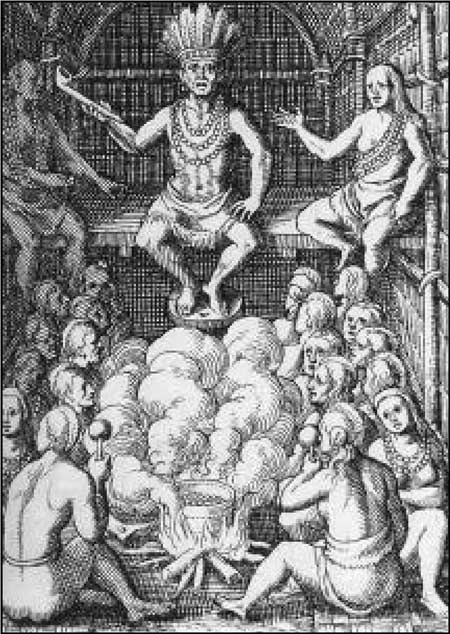
Detail of Captain John Smith's Map of Virginia, 1612,
depicting Chief Powhatan.
1608
January 2, 1608
True to his word, Chief Powhatan releases Captain John Smith
within four days. Smith returns to Jamestown.7
June 2-July 21, 1608
First Expedition Up the Bay
During Captain John Smith's first expedition up the Chesapeake Bay, he
explores various tributary rivers, such as the Patawomeck River. The
Patawomecks come out with canoes filled with deer and bear meat
to share with the English. On their return to Jamestown, the
Patawomeck Chief provides guides to the English to show them
their mine. The Patawomecks (Potomac) traded the silver-like ore
through out the region. As a gift, the Patawomecks allow the English to
take back has much of the ore as they can carry.8
Native Voice
"There was no need for Pocahontas to 'save' Smith! He was being made a werowance."
— Kirk Moore
Pamunkey Tribal Member
March 8, 2004
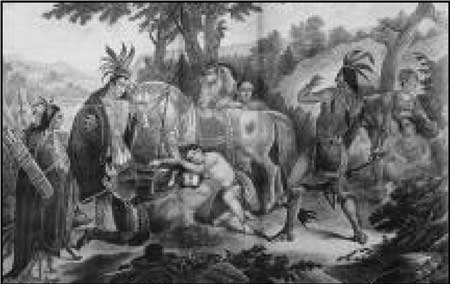
"Smith Rescured by Pocahonta," Christian Inger after
Edward Corbould, 1870 (William W. Cole collection).
July 24-September 7, 1608: Second Expedition
During the second expedition, when the English ship passes by a
Rappahannock village, the Rappahannock Indians are dancing and
singing. Further up river, the following day, the English receive a
volley of arrows. After the assaulting Indians flee, the
Powhatan scout, Mosco, pursues the attackers, with Smith
and his men. Upon their return, they find a wounded Indian. His
name is Amoroleck. Smith has the English doctor dress
Amoroleck's wound. Then Smith inquires as to why Amoroleck's
party attacked them. Amoroleck responds that they had heard
that the English had "come from the under world to take their world from
them." Smith asks him how many worlds he knew of. According to Smith,
Amoroleck states he "knew no more but that which was under the
sky that covered him, which were the Powhatans, with the
Monacans and the Massawomecks, that were higher up in the
mountains."
Near the end of Smith's second expedition, Captain John Smith first enters the Nansemond River, finding four Nansemond villages. Along the river are massive fertile fields producing an abundance of corn. A Nansemond Indian invites Smith into his home. Afterwards, Smith follows a canoe escort further up river, at which time the English encounter seven to eight canoes of Nansemond warriors. According to Smith, the warriors start shooting a multitude of arrows at them. The English return fire with their muskets. Recognizing that the firearms shoot a further distance than their bows, the warriors jump into the river and swim to shore. The English seize the warrior's canoes, and begin to cut one into pieces. The Nansemond warriors returned asking for peace. Smith tells the Nansemond warriors that they must bring him their Chief's bow and arrows, a chain of pearls, and four hundred bushels of corn, or they Nansemonds' homes, villages, corn fields and would burn the destroy their canoes. The Nansemond Indians put their weapons down and return with corn. Smith and his men take all they can possibly carry.9
Native Voice
The Spanish came here looking for gold. The English came here to conquer. I think Amoroleck knew what he was talking about.
— Chief Kenneth Branham
Monacan Nation
May 19, 2000
"There has been some scholarly debate as to whether these 'volleys of shot' were hostile or intended as a welcome.'"
— Karenne Wood
Virginia Council of Indians Chairman Monacan Nation
July 2004
"This myth about their neighbors, the Monacans, was never an issue. These people did not come here to fight, the Cherokees, the Iroquois, they were all the same."
— Kirk Moore
Pamunkey Tribal Member
March 8, 2004
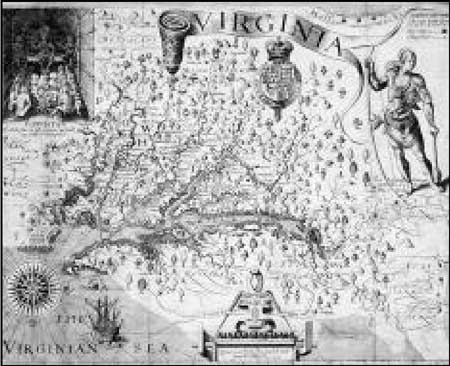
Captain John Smith's Map of Virginia, 1612
Fall 1608
At the coronation of Chief Powhatan, the English present Chief
Powhatan with gifts from England, such as a basin and ewer, and bed.
Chief Powhatan in turn, gives Captain Christopher Newport his
mantle and moccasins.10
Native Voice
"Captain John Smith first entered the Nansemond River in August 1608 and described the Nansemonds as a proud, warlike nation. He located the four villages of Nand-sa-mund, Mat-ta-nock, Teracosick and Man-tough-que-men-o located on both sides of the river. The river was described as a musket shot wide with a narrow channel three fathoms deep. Smith described his slow progress along the river and noted the island (Dumpling) that would be convenient for a fort.
When he approached the western branch of the river, Captain Smith observed the high plains, abundance of houses, people and 1,000 acres of most fertile, sweet and pleasant ground. He saw large corn fields on the mainland; on the island was an abundance of corn. One of the "savages" invited Smith to his house and told him his house was on the island.
As Smith followed a canoe further up the river, seven or eight canoes full of armed men appeared and the first of many hostile encounters erupted. Captain Smith reported arrows came so fast from each side of the river "as two or three hundred could shoot them and those in the canoes let fly also as fast." When Smith and his men fired their muskets, most of the Indians leapt overboard and swam ashore. It was their first experience with gun fire and they found that muskets shot further than bows.
Smith's men seized the canoes and secured them in the open waters. Having seen the large Indian force and suspecting it might be both the Nansemonds and the Chesapeakes, Smith thought it best to take time to consider the next course of action. Should they burn all [houses, canoes and crops] on the island or take all the corn, which was adequate to feed all the Colony (Jamestown)?
During the lull, Smith began to cut the canoes into pieces, whereupon the Indians put down their weapons and made signs of peace. Captain Smith then stated he would accept peace if they brought the King's bows and arrows, a chain of pearls and when we come again give us four hundred bushels of corn. If not, he would burn their corn, houses, all they had and break all their boats. The Indians put away their bows and arrows and brought corn.
John Smith notes that he took all they could carry and departed good friends. The friendly force arrived back at Jamestown on September 7, 1608."
— Oliver L. "Fish Hawk" Perry
Nansemond Chief Emeritus
July 15, 1988
1609
May 1609
A new charter from the King allows the Virginia Company to transfer the
power to governor from the Council over to a Governor.11
Fall 1609
Henry Spelman (14 years old) comes to Virginia in August 1609. Shortly
afterwards, he was sent to live with the Powhatan Indians,
until December 1610. He is later hired as an
interpreter.12
Fall 1609
Captain John Smith is wounded and leaves the Colony, never to return to
Virginia.13
Winter 1609-1610
The region suffers from drought and famine. The winter of 1609-1610
becomes known by the English as the "Starving Time."14
1610
June 7-8, 1610
Sir Thomas Gates decides to abandon the Jamestown Colony. The Virginia
colonists meet a supply ship coming up the James River, with Thomas
West, Lord De La Warr aboard. The colonists return to
Jamestown.15
August 1610
English settlers attack the town of Paspahegh. In the raid the Chief's
wife and children were killed. The village was completely destroyed,
damaging English - Powhatan relations.16
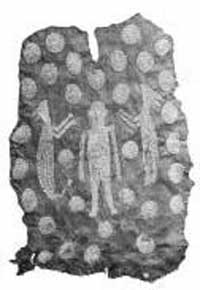
Powhatan's mantle, Ashmolean Museum, Oxford,
England.
Native Voice
"The coronation of Chief Powhatan was a political ploy instituted by the English!"
— Karenne Wood
Virginia Council of Indians, Chairman Monacan
Nation, July 2004
"After that he went to trade with the Patawomecks and made them angry by being deceitful, so they killed some of his men."
— Karenne Wood
Virginia Council of Indians, Chairman
Monacan Nation, July 2004
Some say Henry Spelman was killed by the Patawomecks. That is not correct in our opinion. He was killed by the Anacostians. The Anacostians were not friendly with the Patawomecks. Spelman spoke the Patawomeck dialect after living with them and we believe that he was mistaken for a Patawomeck by the Anacostians and that was the reason that he was killed. We have never found any supported references to a killing by our people of the colonist. We sincerely believe that we were their friends.
— Chief Robert Green
Patawomeck Tribe, October, 2004
1611
1611-1613
John Rolfe conducts tobacco experiments, purchasing tobacco seeds from
the Caribbean Islands.17
1612
June 1612
Jamestown learns the Vi rginia Company is issued its third charter on
March 12, 1612.18
1613
April, 1613
In the Patawomeck area, Captain Samuel Argall kidnaps Pocahontas,
the daughter of Chief Powhatan. Chief Powhatan immediately
offers to pay the ransom. Captain Argall , instead, takes
Pocahontas to Jamestown, holding her prisoner. Both Powhatan oral
tradition and English writings indicate that she was married to a
Powahatan warrior, named Kocoum..19
June 28, 1613
John Rolfe's first shipment of West Indian tobacco is sent on board the
ship, Elizabeth, to England.20
Native Voice
"According to the records we have read, the Patawomecks actually fed the colony during the "the starving time" against Powhatan's orders. We believe that it was out of the friendship that had developed between Sam Argall and Japazaws."
— Chief Robert Green
Patawomeck Tribe
October, 2004
"There are more details available, and you noted elsewhere that the Indians suffered also."
— Karenne Wood
Virginia Council of Indians, Chairman
Monacan
Nation
"Why do you take by force that which you may quickly have by love?"
— Chief Powhatan, 1608
quoted by Captain John Smith
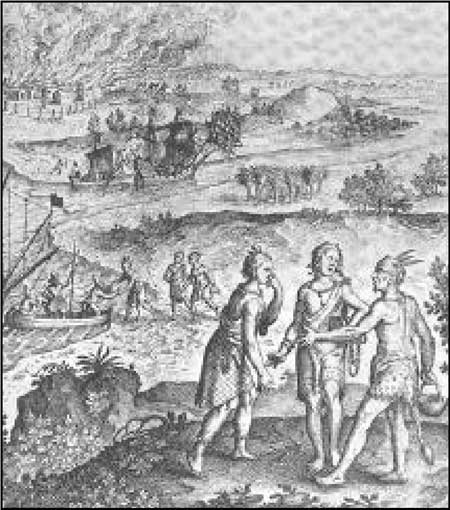
"Iapassus Persuades Pocahontas to Visit Samuel Argall's
Ship," unknown artist, c. 1634.
Native Voice
"Once we apparently formed a relationship with the English, there are very few documented attacks by the Susquehannocks. Because of the pact between Japassus and A rgyle, the English would defend the Potomacs from other tribes. I am convinced that is why Japassus turned Pocahontas over to Argyle. When you're a chief, you have to either sacrifice one person or you have to sacrifice the whole tribe. I'm sure Argyle, although I cannot find it in any of his writings, probably said, 'You either help us get her on the boat or we're no longer going to defend you against the other tribes. It is interesting that Powhatan's favorite daughter should just get turned over to the English by the Potomac and yet Powhatan never takes any action against the Potomac people. You would think if he was incensed and upset about it that the first thing he would have done was come up here and slaughter us. Wouldn't you think so?
What I think happened is that Argyle said 'Well, if you do not help us, you must be against us, and we will no longer be able to defend you against those attacks by those Susquehannocks, and the Massawomecks, and those other tribes.' I think that is where Japassus had to make a decision: Do I protect one girl or do I protect all my people? I think that Powhatan knew that she was going to be turned over before she was turned over. I think Japassus probably sent a message to Powhatan and said, 'I've got Argyle up here and he wants your daughter, and I'm going to turn her over. Let me know if you've got a problem . ' I cannot think of any other explanation. For one, Powhatan takes no retribution. He [Powhatan] comes here and lives after he gives up the throne with Japassus, the man who gave his daughter away. It just doesn't make sense unless he went and said, 'Look, why don't we try and cool this thing with the colonists? Maybe this is the way to do it. I know she's your favorite daughter.' Remember, in that society, even though things were matrilineal, the warrior was still supreme. And so, here is one 12-year-old girl, and I've got all these warriors being killed with these guns, and I've got battles over land, battles over animals. The copper kettle I think was, 'You did me a favor and I give a you a soda to take home with you with a thank you.' I think it was an afterthought. I think it had nothing to do with the exchange. I don't think the premise that they promised her [Japassus's wife] the copper kettle in return for getting Pocahontas aboard is right. I think it is bull. I think it was, 'Okay, we're still friends. You're helping me, here's a copper kettle as a sign of appreciation.' I think it was the threat of dissolving the protection pact that they had with the English was the driving force behind Japassus's decision, not some copper pot.
Argyle professes his love for Japassus and their friendship and their brotherhood throughout his entire writings. I think that Argyle could have said that I won't consider you my brother anymore if you don't help me, but I still think it was the mutual protection against the Massawomecks and Susquehannocks that was the driving force behind his (Japassus), making that decision. Having said that, I think it is clear that Powhatan knew about it before it happened. There is no other explanation for why he didn't take retribution against Japassus and the Patawomeck. Most scholars don't agree with me, but I do not care."
— Chief Robert Green
Patawomeck Tribe
April 20, 2004
1614
1613-1614
Pocahontas is held in custody at either Jamestown and/or the
plantation in Henrico. During Pocahontas's confinement, she is
provided with personal instruction on the doctrines of the Christian
faith. Pocahontas converts to Christianity and takes the name
"Rebecca."21
April 1614
Pocahontas marries John Rolfe.22
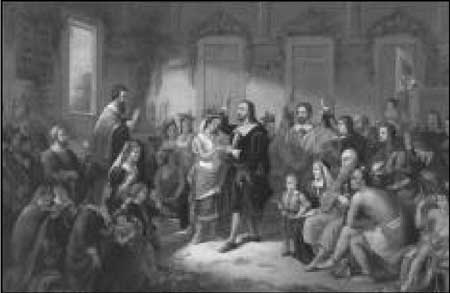
"Marriage of Pocahontas and John Rolfe" by Henry Brueckner
(William W. Cole Collection).
1616
May 1616
Sir Thomas Dale, Pocahontas, John Rolfe, and their baby,
Thomas, set sail for England aboard Captain Argall's
Treasurer. Ten Powhatan Indians, one of which is Chief
Powhatan's priestly advisor, Uttamatomokkin, accompany them.
The Virginia Company arranges Pocahontas's voyage. The goal of the trip
is to secure financial funding for the Virginia Company.23
Native Voice
"In a work published in 1612, Wi l l i a m Strachey noted that Pocahontas had been married to a 'private captain' n a m e d Kocoum 'some two years' previously. This would place her marriage in 1610, or possibly 1611 if his estimate of time was off. She was kidnapped in 1613. Most of the world does not know that she was married to one of her own people at the time she was kidnapped."
— Deanna Beacham
Virginia Council of Indians, Program Specialist
July 2004
"No one knows what happed to the Indian husband at the time?"
— Karenne Wood
Virginia Council of Indians, Chairman
Monacan Nation, July 2004
"Pocahontas was kidnapped and held in captivity."
— Sentiment of Numerous Virginia Indians
Editors Note: Pertaining to the abduction
of Pocahontas Native People used terms such as kidnapped and captivity,
which stresses the violence of the English. While the English, and thus
standardized history downplays the violent nature of the event, using
words such as confinement.
"It should be noted that this is a different tobacco plant from a different botanical species, than that used by American Indians. The West Indian tobacco is related to the tomato family and is poisonous. It is the ancestor of the plant that is cultivated commercially today."
— Karenne Wood
Virginia Council of Indians, Chairman
Monacan Nation, July 2004
1616-1617
Pocahontas, called "Lady Rolfe" by the English, is received as a
royal personage in London. While in London, Pocahontas discovers
that Captain John Smith is still alive. It is arranged for the two to
meet before she returns to Virginia.24
1617
Spring 1617
Prior to their return to Virginia, Pocahontas becomes very ill
and is taken off the ship. Pocahontas dies in England. She is
buried at Gravesend churchyard. John Rolfe leaves their young son,
Thomas, in England in the care of an uncle, and returns to
Virginia.25
1618
June 15, 1618
The George sails from Vi rginia bound for England with about
20,000 pounds of Virginia tobacco.26
Spring 1618
Within a year of Pocahontas's death, Chief Powhatan dies.
After his death, Itopatin is named the paramount chief. Being a
weak chief, Opechancanough quickly succeeds Itopatin.27
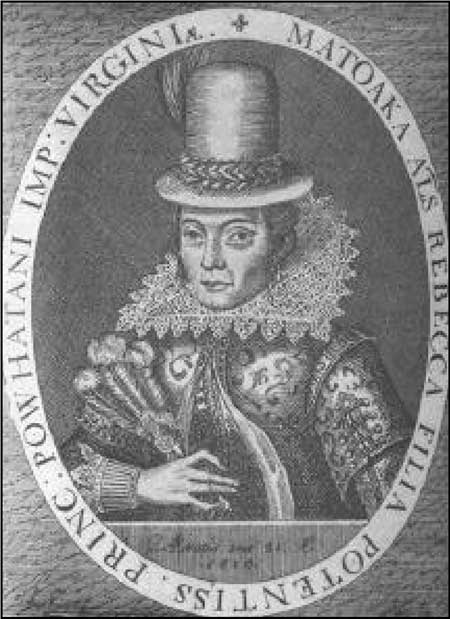
Likeness made of Pocahontas in England from life,
"Pocahontas," Simon van de Passe, 1616.
Native Voice
"Somewhere around this time, Powhatan vows that he will not make war on the English again. I think he kept his word."
— Karenne Wood
Virginia Council of Indians, Chairman
Monacan Nation
1619
Summer 1619
The first English representative government in North America met at
Jamestown. In the subsequent years the General Assembly passes many
laws that will affect the Indians.28
November 1619
The Virginia Company approves sending a group of 90 to 100 young women
to Jamestown to become wives of the settlers. They arrive in Jamestown
the following spring.29
1622
March 22, 1622
Chief Opechancanough leads the first Indian major attack on the
English settlers. At eight o'clock in the morning on Good Friday, the
Powhatan Indians launch a surprise attack on the settlers.
Approximately one third of the 1200 English living on both sides of the
James River in Virginia are killed.30
1622-1623
The English, suffering from food shortages and the spread of disease,
are evacuated to Jamestown Island. Problems are exacerbated by a
constant influx of new immigrants. Cattle are pastured on Jamestown
Island for safety. A plague follows the Indian uprising, leaving less
than 400 English in Virginia in 1623, out of over 5,000 that had
immigrated in the past three years.31
Native Voice
"Pocahontas expresses her displeasure with Smith for not coming to see her in England."
— Karenne Wood
Virginia Council of Indians, Chairman
Monacan Nation
"We think Opitchipan [Itopatin] was the Chief of the Potomac. Now, because Opitchipan was crippled, when the English arrived, they were met by Japassus who was apparently a very imposing figure. Japassus was the lesser chief. The English didn't have a name for our chief or king. We believe it's because Opitchipan, being crippled, was kept out of sight of the English. Coincidentally after Powhatan turns over the supreme chiefdom to Opitchipan, Opitchipan suddenly appears at Jamestown and Powhatan comes to the Potomac tribes to live."
— Chief Robert Green
Patawomeck Tribe
April 20, 2004
1623
Chief Opechancanough sends an emissary to Martin's Hundred stating that the Powhatan people are hungry because of the retaliatory raids by the English on the communities. The Indians offer to return English captives and seek a return to peaceful relations. English remain suspicious of Indian intentions.32
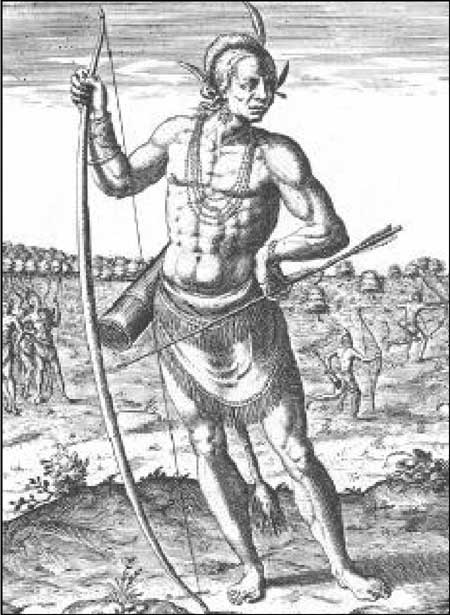
Detail of "A weroan or great Lorde of Virginia," by
Theodor de Bry, 1590.
Native Voice
"If we do not fight, they will destroy us!"
— Opechancanough
quoted by Kirk Moore
Pamunkey Tribal Member
March 8, 2004
"The thing about these time lines is that they do not say why Native People fought. They [the English colonists] took our children. You will fight for your children!"
— Debora Moore
Pamunkey Tribal Member
March 8, 2004
"There were also Indians from the Maryland area who participated."
— Karenne Wood
Virginia Council of Indians, Chairman
Monacan Nation
July 2004
"I think that we had a totally different relationship with Powhatan than did the other Powhatan tribes. This was in part to the distance we were from his main village. This was demonstrated on several occasions, like our refusal to join Openchancanough's rebellion. The Patawomecks did not participate and refused to join Openchancanough's efforts to get them to join with the others. We did not attack or take part in the attacks against the colony."
— Chief Robert Green
Patawomeck Tribe
April 20, 2004
March 1623 — Acts of Assembly at Jamestown by English —
- March 22 to be observed as a "Day of Thanksgiving" by English to commemorate the 1622 Uprising on March 22, 1622.32
- Prohibiting the trade of corn with Indians.33
- Every dwelling house shall have a palisade built around in defense against the Indians.34
October 15, 1623
The King of England is advised to
assume control over the Colony of Virginia. King James requests the
Colony surrender its charter. The Colony refuses.35
1624
The Virginia Company is dissolved. Virginia's government requests regiments of 500 soldiers per year to be sent to fortifications and to suppress the Indians.36
1625
King James I dies. He is succeeded by his son, Charles I.37
1628
The English establish a peace treaty with the Indians and terminate it shortly after."38
1629
October 1629 — Acts of Assembly—
- The governor shall appoint a commander to several plantations. This commander has the authority to gather a posse of men to attack Indians.39
- Assembly agrees that attacks be conducted on the Indians three times during the year: November, March and July, to clear the area of Indians. Several plantations, including Martin's Hundred, listed to attack the Indians. The Pamunkey Indians are targeted for attack before Christmas and in the summer (June, July or August). Every fit man is to participate in the summer assailment against the Pamunkeys in the summer.40
- Three Indians residing among the Colonists are to be supported.41
March 1629 — Acts of Assembly—
- Newcomers to the colony are not required to "march" upon the Indians until after being in the colony one year, unless it is necessary.42
- The war upon the Indians is to be carried out. There will be no peace made with the Indians.43
1631
February 1631 — Acts of Assembly—
- Colonists are prohibited from speaking withIndians. Indians are to be brought to the commander of the plantation or the commander is to be told of the whereabouts of the Indian(s). Failure to do so is a month of service to a free man, and twenty stripes (lashes) to any servant. Exception: in the Eastern Shore area Indians are to be treated with good terms, especially the Mattawombes.44
- All trade with Indians is prohibited.45
- "For the Indians we should hold them our irrecoileable enemies." Commanders are given the authority to "fall out uppon" any Indians lurking about or molesting hogs, etc.46
1632
1632
Peace treaty concluded with Chickahominy and Pamunkey
Tribe.47
September 1632 — Acts of Assembly —
- English are not to speak or parley with Indians, except in Eastern Shore region.48
- Power is given to plantation commanders to raise a posse to attack Indians near a plantation or believed to be "molesting" English cattle, hogs, etc.49
- Neighboring plantations are to assist each other upon alarms of Indian attacks.50
1633
August 1633 —Acts of Assembly—
- No arms or ammunition are to be sold or bartered to the Indians. Penalty: possessions go to the public, imprisonment, and providing service to whoever turned the person in and to the public.51
- Cloth and cotton is not to be traded with the Indians. The colonists are to have first bids. If supplies are excessive, the governor can provide a license to trade cloth to the Indians.52
1630s
In December 1640, Virginia's first Indian reservation was established for the Accomac (Gingoskin) Indians on the Eastern Shore.53 Editor's Note: Today, this area is no longer reservation land, but is still known as Indian town Neck.
1640
January 1640 — Acts of Assembly—
- Price fixing of corn: 16 shillings per barrel.54
- Repeal of the 1637 act prohibiting trade or barter with Indians.55
1643
March 1643 — Acts of Assembly —
- Felony, with death penalty, for a runaway servant to supply arms and ammunition to Indians.56
- English are not to sell or barter arms or ammunition to Indians. Penalty includes loss of whole estate, half going to the informer and the other half to county the offense occurred in. Lending a weapon to an Indian to hunt with carries a lesser fine of giving the arms and ammunition to the informer.57
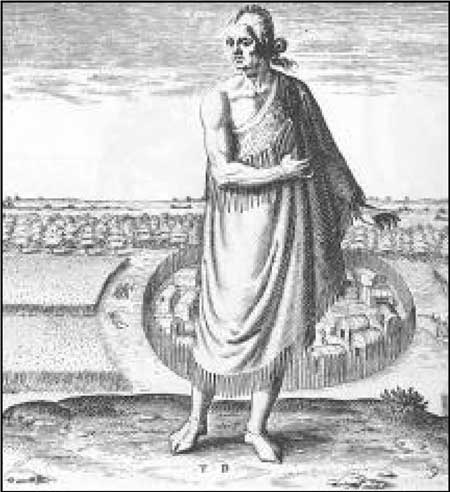
Detail of "An ageed manne in his winter garment,"
Theodor de Bry, 1590.
Native Voice
"There should be some explanation as to why the Indians are so hostile. This whole list sounds like the English did nothing to provoke the attacks!"
— Karenne Wood
Virginia Council of Indians, Chairman Monacan Nation
July 2004
[emphasis original]
"The Bass prominence in Nansemond history originally goes back to the 1638 marriage of Elizabeth, her Christianized name, to John Bass. She was the king of the Nansemond's daughter. The family still own or still has in its possession the prayer book, which documents this marriage in 1638. Basically, that's where our whole line today descends from, from John Bass."
— Chief Barry "Big Buck" Bass
Nansemond Tribe
May 21, 2004
1644
April 18, 1644
Chief Opechancanough, the aged successor of Chief
Powhatan, orders a second surprise attack upon the colonists,
killing some 400 settlers, mostly on outlying
plantations.58
October 1644 — Acts of Assembly —
- Men hurt in the recent expeditions against the Indians are to be cared for by the county they reside in.59
- Six pounds of tobacco was to be taxed on every eligible person to defray the costs of fighting the Pamunkey and Chickahominy Indians.60
1645
February 1645 — Acts of Assembly —
- April 18th to be a yearly day of thanks giving for the deliverance from the Indians.61
- Three counties: Isle of Wight, Upper North and Lower North, to continue the war with the Indians, especially the Chipoaks. The Governor and the council of war are given authority to recruit men to fight.62
- Three forts are to be built. One at the Pamunkey, to be called Fort Royal, another at the Falls of the James River, to be called Fort Charles, and the third at the Ridge of the Chickahominy, to be called Fort James. Some Indians of the Accomack or Rappahannock to be of service to the English.63
November 1645 — Acts of Assembly —
- Settlers who are not able to defend themselves are not to hunt in the woods or travel.64
- Fort to be built at the falls of the Appomattox River, to be called Fort Henry, to prevent the Indians from fishing in that river, and to cut down their corn, among other things. In the counties: Isle of Wight, Upper North and Lower North, war is to be undertaken with the Nansemond Indians, cutting down their corn and other acts of hostilities.65
1646
March 1646 — Acts of Assembly—
- Arrangements for "the great and vast expense of the collony, in prosecuting the warr against our common enemies the Indians."66
- Captain Henry Fleet is to be paid 15,000 lbs. of tobacco, unless peace is made with "Opechancanough or his Indians, our enemies." If peace cannot be made, Captain Fleet shall build a fort any where along the Rappahannock River.67
October 1646
Opechancanough is captured and held prisoner at Jamestown. He is
shot in the back, by one of the English guards, who acted without
orders, and dies.68
October 1646
Chief Necotowance succeeds Chief Opechancanough as leader of the
Powhatan Chiefdom and signs the October 1646 treaty.69
October 1646 — Acts of Assembly — Treaty of Peace
with the signatory tribes in alliance with Chief Necotowance, leader of
the Powhatan Chiefdom
Article 1) Indians are to submit to the King of England, successors to be appointed or confirmed by the King's Governor; the Colony is to protect Chief Necotowance and his people; tribute for such protection of twenty beaver skins, yearly at the going away of the geese, shall be presented to the Governor;70
Article 2) Chief Necotowance and his people are to live and hunt on the north side of the York River without any inference from the English, unless the Governor and Council see fit to allow any English to live there;71
Article 3) Indians cede all the land between the falls of the James and York Rivers down towards Kequotan. It is lawful to kill any Indian in this region, unless he is a messenger from Chief Necotowance. Chief Necotowance is required to hand over any Indian seeking refuge, who escaped the English. To keep the messenger from being killed, a badge of a striped coat is to be worn.72
Article 4) A felony for any Englishman to be in the Indian territory, unless there is permission from Chief Necotowance or the Governor, plus, the English are given until March 1st to seize or kill any cattle or hogs on the north side of the York River.73
Article 5)Limitations of Indian hunting ground: no closer to the English plantations than the head of the Yapin black water to "the old Monakin Towne."74
Article 6)Death to any Englishman who entertains or conceals any Indian within the English limits.75
Article 7) Badges of messengers to be received at Fort Royal for the north side. Death to kill a messenger or one of his party.76
Article 8) Badges and striped coat to be received at Fort Henry, alias Appomattox Forte, for the south side.77
Article 9) Chief Necotowance to turn over any
English prisoners, Negroes, guns, and escaped Indian servants, if
they ran away under the age of twelve years old.78
Article 10) Indian children under twelve years old may live with the English.79
Article 11) Commanders of forts to provide the striped coats to Indians for trade or messengers.80
Native Voice
Indians had to have a pass to travel. They couldn 't testify in court against whites. They couldn't inherit property at one time."
— Oliver "Fish Hawk" Perry
Chief Emeritus Nansemond
1987
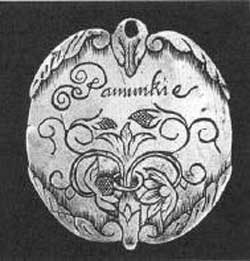
Badge for Pamunkey tribal members.
October 1646 — Acts of Assembly —
- The October Assembly ratifies a treaty of peace, which is agreed to by the Indian leader Necotowance. A significant feature of this treaty is a clause reserving the land to the north of the Pamunkey (York) River to the Indians and making it a felony for an Englishman to settle there.81
- Captain John Floud to be interpreter for the colony with a salary of four thousand pounds of tobacco yearly.82
- Reward of 100 pounds of tobacco to be given to a person for killing a wolf.83
- Land grants north of the York River to be inhabited within three years extended. Persons who have not inhabited land north of the York River due to the 1622 Uprising have until December 20, 1647 to move onto the land.84
- Previous acts prohibiting any terms of peace with the Indians is repealed.85
- The act permitting the English to destroy Indian corn fields is repealed.86
- The act calling for a march against the Nansemond Indians is repealed.87
- Extra taxes are to be levied to defray expenses of the late war.88
1647
November 1647— Acts of Assembly—
- Additional places for Indian messengers to stop for a rest: houses of Captain Edward Hill at Westover, and Captain William Tayler at Chiscake (Kiskiak).89
1653
July 1653 — Acts of Assembly—
- Tottopottomoy has choice of remaining where he and his Indians are at or to go to Ramomak. The Pamunkey and the Chickahominy Indians are to be moved according to a late act of Assembly. Col. John Fludd to oversee the proceedings with Tottopottomoy.90
- Gloucester and Lancaster counties are to assign tracts of land for Indians as hunting grounds.91
- An act of indemnity (a legal exception) to those who have lent guns to the Indians.92
1654
November 1654 — Acts of Assembly—
- Complaints against the Rappahan nock Indians. Assembly authorizes three counties to raise men: Lancaster 100, Northumberland 40 and Westmoreland 30, to meet on the first Wednesday in February to next to Thomas Meades' house. Major John Carter to lead the men to the Rappahannock town demanding satisfaction. Following, Carter is to give account to the Governor, who will determine with his Council, as to peace or war. Captain Henry Fleet and David Wheatliff to go as interpreters.93
- No person to employ Indians with guns unless by license from the county court or the Governor and Council.94
- Commissioners of Northampton County may purchase land from the Indians there, if the Indians desire to sell it, and if the majority of the town agrees. The Governor and Council areto be notified of proceedings.95
Native Voice
"We have a lot of interpreters I think that married into our tribe. A lot of the interpreters' surnames show up in our family names, like the name Cox. The families that were in Virginia before 1700 tended to inter-marry a lot. There weren't a lot of English women around. And who did the English kill? The Indian men, not the women. So there were a lot of Indian women and few Indian men for them to marry. So, it made sense that these interpreters married these Indian women since they spent most f their time with the Indian tribes anyway. So, when you talk about blood quantum, I have no idea what my blood quantum is. When somebody tells me they're pure Indian, I doubt that there are any pure Indians in this part of the country. The Spanish went into the southwest, and then the settlers. The trappers in the north either raped the Indian women or married into those tribes. To me, blood quantum doesn't really matter. Its like an older Elder that Mitchell Bush once introduced me to said, "I know white men that are more Indian than some Indians I know. It's what's in your heart and not necessarily what's in your blood that matters. Your heart tells you whether your are an Indian or not. Do you love and respect Mother Earth?""
— Chief Robert Green
Patawomeck Tribe
April 20, 2004
1656
March 1656 — Acts of Assembly—
- For every eight wolf heads, the King or Great Man [chiefs] shall be delivered a cow. "This will be a step to civilizing them and to making them Christians."96
- Indians who bring their children in voluntarily can choose the persons to entrust the care of their children to, not to be slaves, but to do "their best to bring them up in Christianity, civility and the knowledge of necessary trades." The Englishmen will be paid for such service.97
- Henceforth, land cannot be purchased from Indians without the consent of the Assembly.
- This does not nullify any previous transactions.98
- The county of Northampton authorized to enact laws as to Indians or manufactures, subject to the revision of the assembly.99
- Since shooting off guns is an alarm signal of attacking Indians, no guns are to be shot off, except at marriages and funerals. Penalty is 100 pounds of tobacco.100
- Six hundred to seven hundred western Indians come from the mountains to the falls of the James River. The English consider their presence a threat to the colony, "having cost so much blood to expel and extirpate those perfidious and treacherous Indians which were there formerly." Two upper counties under the command of Col. Edward Hill with 100 men are to first try to remove the Indians without war. Reciting the requirement of the Indians under the Treaty of 1646 to assist the English, the messengers are to be sent to Tottopotomoy and the Chickahominies regarding their advice on the matter.101
- Indians are not to be killed within English territory unless they are doing something suspicious.102
- No Indians to be entertained without license from the county court or two justices of the peace.103
- Indian children can be servants, by leave of their parents, if the children are educated and brought up in the Christian religion.104
Native Voice
"Traditionally, the Chief's role and responsibilities were to make sure that everyone in his village had food, shelter, clothing, and when someone got sick they had someone take care of them."
— Chief G. Anne "Little Fawn" Richardson
Rappahannock Tribe
July 2000
December 1656 — Acts of Assembly —
- Repeal of previous act allowing indiscriminate killing of Indians for minor infractions such as trespassing. No Indian to be killed unless committing an act that would be a felony for an Englishman. A felony to be proved by two witnesses. No Indian is to come within the boundaries of a fenced plantation without a "ticket." Indians can fish or gather wild fruits as long as they do not carry arms or come inside of the fenced plantations. All free men may trade with the Indians.105
1658
March 1658 — Acts of Assembly —
- Penalty for selling arms to Indians is the forfeit of one's entire estate, half to the informant and the other half to the County. A gun lent to an Indian may be seized.106
- Indian servants of 16 years old, male and female, are to be taxed.107
- Indian children within English custody are not to be transferred to another custodian for any reason. Such children are to be free at age 25.108
- No land grants to be issued until each Indian bowman receive his 50 acres. Any Indian land within already granted patent must be bought from the Indians or relinquished.109
- Indians to be employed to kill wolves, without English weapons.110
- Due to the many complaints coming in about the wrong done to the Indians by taking away their lands, the Assembly passes an act stating that the Indians are to keep their lands they now possess and no Englishman can settle a claim there without consent from the Governor and Council or commissioners in that place. Recent settlers near the Pamunkey Indians and Chickahominy Indians are recalled.111
- Editor's Note: This one section of the English records is
quoted verbatim due to the extensive insights within the text, thus
allowing the reader to draw his or her own interpretation.
"WHEREAS many complaints have bin brought to the Assembly touching wrong done to the Indians, in the taking away their land and forcing them into such narrow streights and places that they cannot subsist either by planting or hunting, and for that it may be feared they may justly driven to despaire & to attempt some desperate course for themselves, which inconveniencies though they have bin endeavored to be remedied by former acts of Assembly made to the same purpose, Yet notwithstanding manie English doe still intrench upon the said Indian's land, which this Assembly conceiveing to be contrary to justice, and the true intent of the English plantation in this country, whereby the Indians might by all just and faire waies be reduced to civility and the true worship of God, have therefore thought fitt to ordeine and enact, and bee in hereby ordained and enacted, That all the Indians of this collonie shall and may hold and keep those seates of land which they now have, and that no person or person whatsoever be suffered to intrench or plant upon such places as the Indians claime or desire untill full leave from the Governour and Councill or com'rs. [commissioners] for the place; Yet this act not to be extended to prejudice those English which are now seated with the Indians' former consent unless uppon further examination before the Grand Assemblie cause shall be found for so doeing, And the said com'rs. shall be accomptable before the Governour and Councill and the Grand Assembly if any wrong or injurie be done to the Indians contrary to the intent of this act, And be it further encated, That the Indians as either now or hereafter shall want seates to live on, or shall desire to remove to any places void or untaken upp they shall be assisted therin, and order granted them, for confirmation thereof, And no Indians to sell their lands but at quarter courtes, And that those English which are lately gone to seate neare the Pamunkeys and the Chickahominies on the north side of Pamunkie river shall be recalled and such English to choose other seates else where, and that the Indians as by a former act was granted them, shall have free liberty of hunting in the woods without the English fenced plantations, these places excepted between Yorke river and James river and between the Black water and the Manakin towne and James river, and noe patent shall be adjudged valid which hath lately passed or shall pass contrary to the sense of this act, Nor none to be of force which shall intrench uppon the Indians' lands to their discontent without expresse order for the same."112 - Against employing Indians with guns.113
- Northampton Commissioners to take acknowledgement of Indian Lands.114
- For preservation of the peace with the Indians by entertaining Indians without leave.115
- Due to a problem with Indian children being stolen from their parents and sold to the English by other Indians, no person shall buy an Indian from the English. If a person has done so, ten days are allowed to return the Indian child from where he/she was taken. The informant receives 500 pounds of tobacco.116
- Wiccacomoco Indians allegedly deserted their land, thus it was granted to Samuel Mathewes on November 27, 1657 and confirmed on March 11, 1658.117
- Indians may carry their own guns within their own territory.118
- Upon the death of interpreter Col. John Flood, his son, Thomas Flood, is hired to take his place for the same salary.119
- Since both the English and foreigner plantations are trading guns and ammunition to the Indians for beaver to their gain, and the colony's loss, free trade with the Indians will be permitted starting April 1, 1660.120
Native Voice
"Somewhere around this time, a group of Monacans move to a village near Ft. Henry, and a battle occurs between the English (with Powhatan allies) and the Monacans. The Pamunkey Chief Totapotamoi [Tottopotomoy] is killed."
— Karenne Wood
Virginia Council of Indians, Chairman
Monacan Nation
July 2004
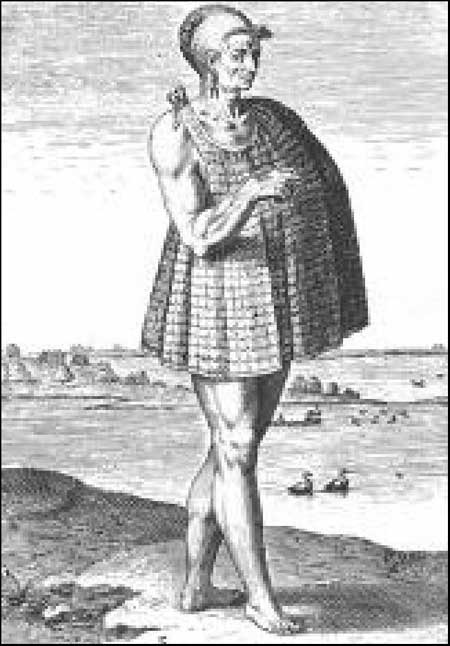
Detail of "On a Religeous men in the towne of Secota,"
Theodor de Bry, 1590.
1660
March 1660 — Acts of Assembly —
- Because the Indians are unaccustomed to English law and imprisonment, and out of fear of inciting a war with the Indians, any English trading with the Indians who allows an Indian to build up a debt, does so at his own risk. The Assembly will not permit English laws of debt recovery be applied to the Indians.121
- The King of Weanoak incurs debt with the English beyond his ability to pay back. He is put in prison. In prison, he petitions the government to grant him protection from arrest until the first of the following March.122
- John Beauchamp, merchant, is granted permission to take his Indian boy to England, if county court in Charles City County receives the parent's consent.123
Native Voice
"There should be some foreshadowing of this, earlier in the timeline. It is the reason for all of the earlier acts by the English intended to protect themselves. The same is true in Maryland colonial records, except that Indians were allowed to address the colonial government during its meetings. The way this timeline is written, it appears that the Indians were the bad guys for a long time before this Act became necessary!"
— Karenne Wood
Virginia Council of Indians, Chairman
Monacan
Nation, July 2004
October 1660 — Acts of Assembly —
- Accomack Indians, also known as "Gingaskins," complaining that the English are getting too close to them, their corn is being damaged. Surveyors are to survey out enough land for them to fish and hunt.124
- There is a dispute over whether the land granted to Col. Mathewes was actually agreed upon by the Wiccocomoco Indians or not. To settle the dispute the Wiccocomoco Indians are to be offered payment for the lands. If they accept, the land will belong to Col. Mathewes' heir. If not accepted, the land will belong to the Wiccocomoco Indians until they leave the land. If they leave the land, Mathewes' heir is entitled to the land.125
- Col. Fantleroy claims to have the consent of the Indians to purchase land from them. However, he does not have any evidence to back it up. The Assembly will take the matter up at the next session. Col. Carter is to defend the rights of the Indians.126
- John Powell complains of the Indians damaging his property.
The Northumberland commissioners are to look into the matter and
determine if there is enough proof to support Powell's claims. If there
is evidence, then the chief of the Indians is to be approached to comply
to pay for the damages. If the chief refuses, the court will decide how
many Indians may be apprehended and sold asslaves in a foreign
country.127
March 1660 — Acts of Assembly —
- Only persons who have obtained a license may trade with the Indians. Penalty for first offense: 500 lbs. of tobacco, 2nd offense 1000 lbs. of tobacco, and 3rd offense 1,500 lbs. of tobacco, along with all trading goods.128
Native Voice
"Of course, we would like to have all our land back. You asked for dreams. But we know better. They would have to give us half of the state of Virginia back."
—Ronnie Branham
Chief Emeritus Monacan Nation
1987
1661
March 1661 — Acts of Assembly —
- Lands of the Chickahominy Indians confirmed, no purchase to be made from them except by the quarter court or the Assembly. "UPON the petition of Harquip the Mangai of the Chickahominy Indians to have all the lands from Mr. Malorys bounds to the head of the Mattaponi river & into the woods to the Pamunkeys. It is accordingly ordered that the said land be confirmed to the said Indians by patent, and that no Englishman shall upon any pretence disturbe them in their said bounds nor purchase it of them unless the major part of the great men shall freely and voluntarily declare their consent in the quarter court or assembly."129
- Major General Manwaring Hamond claims that 2000 acres within land granted to the Chickahominy Indians was granted him by patent. The Assembly states that he is required to either purchase the land from the Indians or obtain their consent to preserve the country's honor and reputation.130
- In the controversy over land by Col. Fantleroy and Indians, the Assembly judged that since Fantleroy had provided some compensation for the land, and Fantleory had constructed buildings and cleared the land, which the Indians were unable to pay for, the land would go to Fantleroy. Fantleroy is to pay Mr. Mathew Kempe 30 matchcoats of two yards apiece, with one trimmed in copper lace for the chief, for the service of the Indians.131
- Because the Chesskoiack Indians have been kind to the English and have obeyed English laws, the Assembly grants the continued use of the land they are presently on, as well as holding guns in their possession.132
- Harquip Mangoi of the Chickahominy Indians, on April 4, 1661, acknowledged efore the Grand Assembly the sale of 743 acres of land from the cliffs to the little creek to Mr. Phillip Mallory.133
Native Voice
Editor's Note: The mention of Indian slavery in the English records is significant verification of Native oral tradition, which states that Indian slavery occurred with the English, as well as the earlier Spanish excursions.
"WOW!! This is not the usual information [history] we are usually given."
—Mitchell Bush
Virginia Council of Indians, Indian At Large
Onondaga Tribal Member
July 2004
Editor's Note: Most Virginia Indian Tribes still view many of the acts of the English in the seventeenth century as cruel, and need to presented within the historical narrative.
1662
March 1662 — Acts of Assembly—
- Repeals any acts inhibiting free trade among inhabitants of the colony/country, except with Indians. Trade with Indians for beaver, otter and other furs must be commissioned by the Governor.134
- John Flood's son to take his place as an interpreter, and Henry Newcombe to be interpreter in the northern region.135
- This act prohibits the selling or buying of Indian lands, any contracts are null and void.136
- Any Englishman who cannot produce good evidence of title on Indians lands shall be removed by the sheriff; any constructed buildings are to be demolished and burned.137
- Englishmen within three miles of the Indians are to assist in making a fence around the cornfields of the Indians, in order to protect the crops from the cattle and hogs of the English. It is up to the Indians, however, to maintain the fence.138
- Indians may obtain a license to gather oysters and wild fruits for a given period of time. They, however, may not carry any weapons with them. If the English harm the Indians, the English are to be prosecuted as if the harm had been done to an Englishman.139
- There is to be no trade with the Indians whatsoever except by commissions by the Governor.140
- The Governor to hear disputes of trades with the Indians.141
- An Indian chief cannot be imprisoned without a special warrant from the Governor and two Council members.142
- The Governor is to appoint commissioners without personal interest in the area to go to the Indian towns to tell them of the English acts passed for their protection. Commissioners are to go annually to insure that their (Indians') rights are not being violated.143
- Silver-plated and copper plated badges are to be provided to the chiefs under the protection of the English. Indians, or at least one Indian within the group, coming into English bounds are to wear one of these badges. If the Indians are found in harming any English, the chief associated with the badge will be held responsible. Indians found English bounds without a badge are to be apprehended and taken to a justice of the peace, and held in safe custody until the chief, or "great man," pays 100-arm length of roanoke (shell beads) for each Indian.144
- Any Englishman proven to have taken a badge away from an Indian shall be fined two hours in the "pillory" and 5,000 pounds of tobacco. If the Englishman is unable make such a payment, he is to spend six months in prison.145
- Tributary Indian Kings are to send one of their great men to the English militia at the notice of approaching strange Indians to give a report of their knowledge of the Indian group.146
- The English are not to harbor runaway Indians from their respective tribes.147
- Indian servants are not to be sold as slaves, nor held in service longer than expected of an English servant.148
- Indian servants are permitted only by license obtained from the Governor. The Englishman with the license is responsible for the actions of the Indian servant.149
- Wahanganoche, King of the Patawomeck Indians, is acquitted of murder charges by Captain Giles Brent.150
- Chief Wahanganoche of the Patawomeck Indians is to be paid 200 arms length of roanoke by Captain Giles Brent, and 100 arms length of roanoke by other accusers, Colonel Gerrard Fowke, Mr. John Lord and Captain George Mason. Matchcoats of 20 arms length can be substituted for the roanoke.151
- Colonel Gerrard Fowke is fined 10,000 pounds of tobacco for allowing one of the murderers to escape (presumably an Englishman).152
- Captain Giles Brent and Colonel Gerrard Fowke issued an illegal warrant for Wahanganoche, King of the Patawomeck Indians' arrest. They are fined 15,000 pounds of tobacco. They can no longer hold civil or military positions. Brent is to pay the costs of the witnesses. Fowke is to pay whatever charges remain.153
- Colonel Moore Fantlorey has built a house in the lowland near marshes. It appears that he wants 500 acres of high land ground instead. He is to pay the King of the Rappahannock 15 match coats prior to moving and 30 upon acquiring the uplands.154
- Colonel Moore Fantlorey falsely accused the Rappahannock Chief of not paying tribute to the Governor, Sir William Berkeley. Colonel Moore Fantlorey is relieved of any civil or military office.155
- White receives 10,000 pounds of tobacco from the public trust to compensate for the murder of his son and two servants by Indians.156
- Trade is prohibited with Marylanders and northern Indians, such as the Susquehannocks. It is feared that the well-worn paths will bring danger from northern Indians and they will also trade with the tributary Indians in Virginia, which would hurt the colonists trade with tributary Indians.157
- It appears that Mrs. Mary Ludlow, estate executive for the late Collonel Thomas Ludlow, has encroached upon the Chiskiack Indian land at Pyanketancke. The Ludlow heirs are to have only the land as previously surveyed. A commission appointed by the Governor is to settle all disputes.158
- Wahanganoche, King of the Patawomeck Indians, acknowledged before the committee of Indian businesses [first noticed mention of such a committee] that he has sold a parcel of land to Mr. Peter Austin for matchcoats. Trees will be marked to establish the boundaries of this land.159
- Commissioners appointed by the Governor shall settle Land disputes between Colonel Gerard Fowke and Wahanganoche, King of the Patawomecks.160
- Commissioners appointed by the Governor shall settle Land disputes between Captain Giles Brent and Wahanganoche, King of the Patawomeck Indians.161
- Lieutenant Colonel Goodridge is summoned to appear before the Governor and the Council to answer complaints by the King of the Mattaponi Indians concerning the burning of his English house.162
- John Carter to issue a warrant for William Johnsons concerning
whether an Indian boy should remain with the English or be returnedto
the Indians.163
- Metappin, a Powhatan Indian, sold for a lifetime of service to Elizabeth Short by the King of the Wainoake (possibly the Weynoke) Indians, is to be set free. The King of the Wainoake Indians could not legally sell Metappin because he was of another nation. Metappin can speak perfect English and desires to be baptized.164
- The Assembly upon the advice of the committee appointed for the Indian business requests that the Governor appoint uninterested person to enquire on differences between the English and the Indians.165
Native Voice
"I'm sure that they went to Wahanganoche and wanted land, but he wouldn't give them any land. So, they accuse him of treason and murder, and he gets hauled down to Middle Plantation, which is Williamsburg today. And he gets tried, and he was found innocent."
—Chief Robert Green
Patawomeck Tribe
April 20, 2004
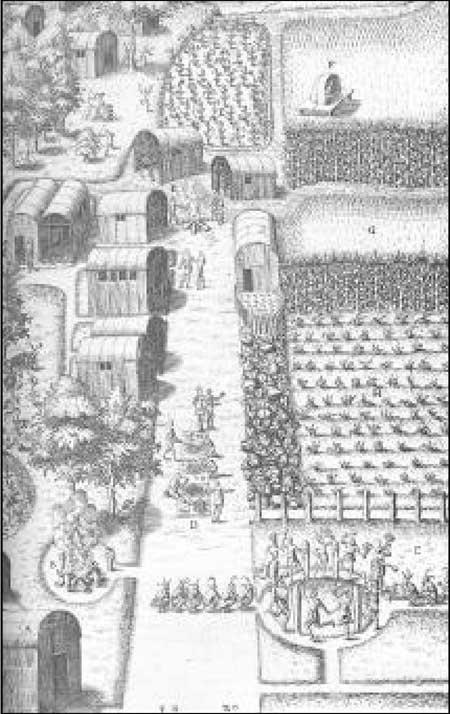
Detail of "The Towne of Secota," Theodor de Bry,
1590.
1663
September 1663 — Acts of Assembly —
- Tributary Indians (Virginia Powhatans) claim that other Indians, such as the Tuscarores, are committing the diverse thefts on the south side of the James River. English are prohibited to entertain any Indian without a badge. The English who do so will be subject to the same punishment as the Indians who enter English territory without a badge. The informer of such actions will receive half the penalty.166
- The King of the Patawomeck and other northern Werowances and Mangays (chief men) are to deliver such hostages of their children or others as shall be required, if not they will be considered enemies of the English.167
- If any Englishman be hurt or killed, the nearest Indian nation
to the incident is to produce the culprit, or else they will be
considered actors in the crime.168
Editor's Note: This shows the English are applying the concept of entire group responsible for the actions of a few. - If any strange Indian(s) shall come into their territory, they are to pursue them as enemies. If they do not have the manpower to deal with the incoming Indians, chief men are to be sent to the English, providing information of the situation, and the English will assist them.169
- The Patawomeck Indians and their neighboring Indians are to seek out to the best of their abilities the late murders and those committing other mischief against the English.170
- All Indian nations are to join in and pursue the
Doeggs who confessed to be the actors in the first murders of the
Occaneechis and the Monacans.171
Editor's Note: This is an example of developing English policy whereby the English pressure the tribes to act in their self interest, resulting in factionalism among the tribes. - If the Doeggs come in the future to trade with them, they are to turn the Doeggs over to the English.172
- The King of the Patawomeck is not to hold Matchacominco [council] with any strange nation without the militia having knowledge of it beforehand, or before the hostages be delivered as according to this act.173
- The Indian hostages shall be well cared for and educated. Those caring for them shall receive 1200 pounds of tobacco a year.174
- An Indian, who carries away such a hostage and does not return the hostage, shall be considered and proceeded against as an enemy.175
Native Voice
"Even though colonial records mistakenly call chief 'king,' this timeline should avoid doing so."
—Karenne Wood
Virginia Council of Indians, Chairman
Monacan Nation, July 2004
Editor's Note: Ms. Wood is not the only person to comment on the English usage of "king." One objective of this time line is to bring these differences of perspective on history to the forefront. Word usage contains many hidden cultural and political perspectives. The usage of "king" verses "chief" distinguishes difference between English and Indian perspective, as well as a difference between the seventeenth century and contemporary language usage.
I think that once he [Fowke] gets back and the Indians don't leave, the English suddenly say, 'Well, if we kill them, they won't be living on the land and we can claim it.'"
—Chief Robert Green
Patawomeck Tribe
April 20, 2004
1665
October 1665 — Acts of Assembly—
- Since the Dutch were trading the Indians guns and ammunition the English were allowed to do so, as well. However, now that the Dutch are gone, the General Assembly forbids the sale of guns and ammunition to the Indians.176
- The 1633 act holding the northern Indians accountable for the murders of English on the nearest Indian town is extended to all Indians. Commissioners will be appointed to enforce this act.177
- Indians no longer can determine their own Werowance or
chief commander, but instead the Governor is to appoint the successor.
If the Indians refuse, they will be considered
enemies.178
Editor's Note: This indicates clearly an emerging policy that the English colonial government will select and appoint tribal leaders according to their own interests. - Penalty for harboring, employing or entertaining an Indian without permit will be 5,000 pounds of tobacco or one year in prison.179
Native Voice
"Because our tribe was a matrilineal society, we had female leaders in the seventeenth century. There were actually two Rappahannock Chiefs. But in all actuality in 1684, our tribe was consolidated with the Nanzatico Tribe. The Nanzatico Tribe was actually a sister village of the Rappahannock domain. There was an English family that had been burned out and murdered nearby. The colonial authorities automatically assumed because the Nanzatico were the closest tribe to them that it was them that had done that. So, they went in and they hung all of the young men in the town square. The women and the old men were sold into slavery to Antigua because the Indian commissioner's daughter at the time was engaged to be married to the ambassador to Antigua. They sold them into slavery and the children were bound out to English families to be servants. Since the English were unable to distinguish the Rappahannocks from the Nanzatico, the Rappahannocks claimed a number of Nanzatico people as Rappahannock to prevent them from being murdered or sold into slavery. Because of all the men being taken, there emerged a woman from the Nanzatico that was Chief, and then a Rappahannock woman who was Chief. So, we ended up with two Chiefs, or Queens, as the English termed them, at the same time."
— Chief G. Anne "Little Fawn" Richardson
Rappahannock Tribe
July 2000
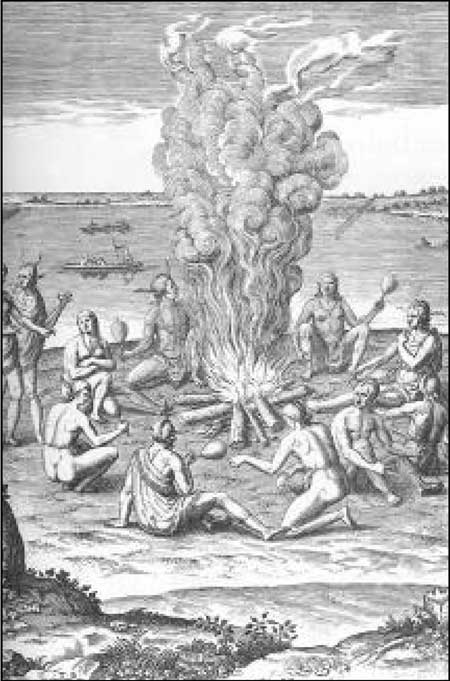
Detail of "Their manner of prainge with Rattles abowt te
fyer," Theodor de Bry, 1590.
1666
October 1666 — Acts of Assembly—
- The paying of Indians for killing wolves has become burdensome beyond benefit. T h e Assembly grants each county to determine the amount of award, if any.180
- Realization that holding the closest neighboring Indian town
responsible for the murder of an English person does not pertain to
probable guilt, the Assembly will make a test case out of Henrico
County, being on the frontier. After, the north side of the James River
is to be secured with set boundaries, as the south side, any
Indian entering the English boundaries can be legally killed. If
it goes well in Henrico, they will apply the same principle to other
counties.181
Editor's Note: Indians must have a permit to work on land that was "native" land at the beginning of the century. The ultimate penalty of this was death.
Native Voice
"This is another neighborly act affirming Indian sovereignty!"
—Karenne Wood
Virginia Council of Indians, Chairman
Monacan Nation
July 2004
1669
October 1669 — Acts of Assembly—
- Tributary Indians are to kill a certain amount of
wolves each year.182
County Indian Group Bowmen Wolves Nansemond Nansemond 45 9 Surrey Pawchay-ick 30 6 Weyenoake 15 3 Charles City Nottoway (2 towns) 90 18 Appomattux 50 10 Men-Heyrick 50 10 Henrico Manachee 30 6 Powhites 10 2 New Kent Pamuncy 50 10 Chickahomony 60 12 Mattaponi 20 4 Rappahanock 30 6 Totas Chees 40 8 Gloucester Chiskiack 15 3 Rappahannock Portobacco 60 12 Nanzcatico & Mattehatique 50 10 Northumberland Wickacomico 70 14 Westmoreland Appomatux 10 2
Editor's Note: This list gives us some idea of the extent of the tribes population size, by county, in 1669. Modern county lines may differ from seventeenth century boundary lines. Note absence of tribal listings for James City and York counties. - Counties courts are to appoint a person to take in and keep track of the killed wolves. If the quota is not meet by the Indian group, the great man [chief] is to come and explain the situation for the default, where they shall be warned to meet the quota. If the quota is not met, the contempt will be addressed in the next assembly. If more wolves are brought in than required, they shall be paid 100 pounds of tobacco and cask (a wooden barrel.)183
- At the next Assembly they will decide if the wolves brought in can be in lieu of the tribute. Also, since it is unlawful for the Indians to come in among the English, they need to be issued licenses to bring the wolf heads into the English communities.184
1670
October 1670 — Acts of Assembly —
- No free Indian or Negro can purchase a Christian servant, but can buy any from their own nation.185
- The act encouraging the Indians to kill wolves and pay their tribute in wolf heads has not produced the desired effects.186
- To settle disputes as to whether Indians taken in war by other nations can be sold to the English should be for life or a number of years, the Assembly decides that servants, not being Christian, imported into the colony are for life, whereas, servants brought by land, if boys or girls, until the age of 30, if men or women, twelve years and no longer.187
1671
September 1671 — Acts of Assembly —
- The act of making it lawful to kill any Indian entering Henrico County is repealed. Indians are permitted to come into Henrico County for lawful occasions. However, legal permits must be obtained prior to entertaining any Indians.188
Native Voice
"Most of the Upper Mattaponi people have the last name Adams, including myself, and that came about through an interpreter that lived among the Indian people in the early 1700s."
— Chief Kenneth Adams
Upper Mattaponi, March 17, 2001
Editor's Note: An interpreter with the name James Adams appears in the James City County records on April 26, 1705. See chart.
1674
Septembers 1674 — Acts of Assembly —
- Due to the difficulty of proving hog stealing, the testimony of Indians will be admissible and Indians are to mark their hogs.189
1676
Editor's Note: The Acts of Assembly from 1676 are worth reading carefully. These acts point to the growing frictions and tension that erupt into physical violence between natives and settlers. The friendly tribes suffer at the hands of their English neighbors in what has become known as "Bacon's Rebellion." This is one of the most devastating events of the seventeenth century for tributary Indians.
March 1676 — Acts of Assembly —The English Declare
War on the Indians.
- War shall be declared on Indians who are notoriously known or shall be discovered to have committed murders, aiders and abettors, Indians who refuse to hand over hostages, or other security to show their fidelity and good affections to the English, and Indians refusing to aid the English in discovering, pursuing and destroying those enemies.190
- The whole colony/country shall help finance this war.191
- 500 men shall be pulled out of the colony, especially from the more secure, interior counties to enter into standard pay. Col. Nathaniel Bacon, Esqr. From Yorktown.192
- A few Indians to be employed and paid with matchcoats for services.193
- Certain Indians agree to Col. George Mason's request to seek out the murders. For every prisoner brought back alive, three matchcoats will be awarded, for the head of every one killed, one matchcoat.194
- Death to English or Indian who give private intelligence to the enemy.195
- Not only are the colonists being murdered in the frontier regions, but increasingly in the more prominent areas. The Assembly states that the Indians have been emboldened by the large amounts of guns and ammunition they have traded for. Thus, this act places a death penalty on trading guns and ammunition with the Indians.196
- To enforce this act, the Assembly states that no English shall go into an Indian town, or carry more than one gun and ten charges of powder outside a plantation. If found with more, the English will be punished as if he was trading guns and ammunition with the Indians, whether he was or not. Since there are friendly Indians living amongst the English who would perish without the necessities of matchcoats, hoes and axes to tend their corn fields, each county will appoint five commissioners to trade necessities with the friendly Indians. Trading with Indians is barred exclusively, except for these five commissioners. Penalty for trading with Indians is 10,000 pounds of tobacco or one year in prison.197
Native Voice
"Even thought treaties had been made and the Indians segregated by means of reservations, the colonists continued to intrude on Indian land. In 1607, the Indian population in Powhatan's realm was approximately 14,000. It had decreased to 2,000-3,000 by 1670 and the settlers had increased to approximately 40,000."
— Oliver L. "Fish Hawk" Perry
Nansemond Chief Emeritus
September 16, 1989
"Bacon's Rebellion was sort of the same thing (as the taking of land by Fowke). Bacon and his supporters thought that the Governor and the colony were looking out for the Indians too much. Protecting them. That was one of the main reasons for Bacon's Rebellion. When these landowners weren't allowed to take the Indian lands, they felt that the Governor was mollycoddling the Indians. They wanted to be able to take the Indian lands for their own. I think that the attack against the Patawomecks in 1666 was just a lead-up to Bacon's Rebellion."
— Chief Robert Green
Patawomeck Tribe
April 20, 2004
April 1676
Nathaniel Bacon is chosen by frontiersmen to be their leader in a
campaign against the natives.198
June 1676 — Acts of Assembly—
- War is declared on the Indians. However, the English want to distinguish between hostile and friendly Indians.199
- Indians shall be considered enemies if they have or in the future abandon their customary towns without first obtaining a license from the Governor.200
- To be considered friendly, Indians must turn in all weapons, excluding bows and arrows.201
- AllIndian towns are to give an account of name and number of all Indians in their town. Failure to do so will be considered enemies.202
- 1,000 militiamen to be raised, one eighth to be horsemen.203
- Indians taken captive in the Indian war shall be slaves for life.204
- The previous act allowing five commissioners to trade with the
Indians is repealed due to corruption. All trade with Indians is
prohibited. However, Indians fighting with the English shall
have access to guns and ammunition.205
- Friendly Indians may continue to fish and hunt within their limits with bows and arrows. The English may trade fish, canoes, bowls, mats or baskets for corn from friendly Indians. If any Indian items other than these are found in the houses of the English, the English person shall be fined 1,000 pounds of tobacco, half to go to the public and the other half to the informer. A chief officer must certify Indian items taken in war; the justice of the peace is to be notified. Anyone having Indian items prior to this act must obtain a certificate from the justice of the peace. Any English person killing a beaver, otter, or wildcat on their own must immediately take the skin(s) to be certified by the justice of the peace.206
- Any land deserted by Indians shall be put on reserve to sell to defray the cost of the war. The land shall not be patented to the English, but sold.207
Native Voice
For over three hundred years, scholars and historians have debated the cause of Bacon's Rebellion without reaching a definitive conclusion. Governor William Berkely and Nathaniel Bacon, Jr. have each been vigorously accused and defended as the villain of the infamous insurrection of 1676-1677. Even though many problems existed in the colony, both real and fictitious, the Governor and the rebel soon agreed on at least one issue — the extermination of the Indians.
— Oliver L. "Fish Hawk" Perry
Nansemond Chief Emeritus
September 16, 1989
June 1676
Governor Berkeley and the Assembly make Bacon the commander-in-chief of
the forces to fight the Indians.208
June 1676
Nathaniel Bacon leaves Jamestown with his followers to march against
the Indians.209
Native Voice
"He [Nathaniel Bacon] also convinced the Occaneechis to attack a Susquehannock fort, and then he attacked the Occaneechis after their victory and murdered almost all of them."
— Karenne Wood
Virginia Council of Indians, Chairman
Monacan Nation
July 2004
"Because he [Nathaniel Bacon] wanted Gov. Berkeley's job, I heard."
— Karenne Wood
Virginia Council of Indians, Chairman
Monacan Nation
July 2004
August 1676
Nathaniel Bacon crosses the York and raids friendly, tributary Indians,
such as the Pamunkeys. Instead of fighting back the tributary
Indians, who signed the 1646 Treaty of Peace, try to escape and hide
from Bacon and his men.210
September 1676
Nathaniel Bacon enters Jamestown and sets it on fire, after which he
returns to Gloucester. He died a month later in Gloucester of the
"bloody flux" and "lousey disease."211
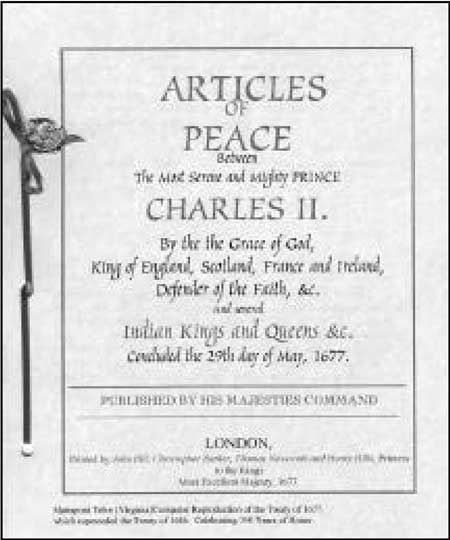
Reproduction of the Treaty of Middle Plantation 1677.
1677
May 29, 1677
After Bacon's Rebellion, the Queen of the Pamunkeys, Cockacoeske,
approaches the Colonial government to update the 1646 Treaty of Peace.
The 1677 Treaty is signed at Middle Plantation in Williamsburg,
Virginia.212
February 1677 — Acts of Assembly —
- Arms and ammunition may be sold and traded to any colonists, the Indians of the eastern shore, and other friendly neighboring Indians.213
- The cost of the war with the Susquehanna Indians shall be born by the public.214
- The counties are to pay for the war against the Indians.215
- Indians taken captive in war may be retained as slaves, and the soldiers may retain the plunder.216
October 1677 — Acts of Assembly —
- Total prohibition of trade with Indians is found to be
hurtful. Free trade with all friendly Indians is to resume.
Indians may come to the English region on certain days to trade.
Marts or fairs are to be established for this trade. The English are not
to trade with Indians at any other place, but the deemed markets.
There shall be an account kept of all that is traded at the market.
Exceptions are made to the Wiccocomico Indians in Northumberland
and Chiskiack Indians living in Gloucester: the respective
counties may set up their own times and rules. Indians are to
come to the markets unarmed, but may carry back arms, if they are
recorded with the clerk. Indians may be entertained within
individual homes with a license to do so.217
Editor's Note: This was treaty between Charles II of England the Virginia Indians, which repeats many of the articles of peace from the 1646 Treaty. Several of the articles from this treaty were enacted into law by the General Assembly.
Native Voice
"The Pamunkey Queen emerged as a very powerful leader. She actually negotiated the Treaty of 1677 on behalf of all the Powhatan tribes. Women were prominent in government."
— Chief G. Anne "Little Fawn" Richardson
Rappahannock Tribe
July 2000
1679
April 1679 — Acts of Assembly—
- Reiteration of soldiers being free to keep plunder from Indians and sell Indian captives as slaves.218
1680
June 1680 — Acts of Assembly—
- All limitations of trade with friendly Indians repealed
until the next session.219
1682
November 1682 — Acts of Assembly—
- Repeal of Act XII, October 1670 concerning the tenure of slaves. Except for Turks and Moors, any person from a nation not known to be Christian can be sold as slaves, regardless of where they are from or whether they are converted to Christianity.220
Native Voice
"An earlier act prohibited Indian slavery. Now it is okay?"
— Karenne Wood
Virginia Council of Indians, Chairman
Monacan Nation
July 2004
Editor's Note: Ms. Wood points to an interesting aspect in colonial English culture, which requires further research into the English colonial distinctions between slavery and captivity.
1691
April 1691 — Acts of Assembly—
- Customs and licenses required for exporting Indian goods, such as furs, outside the country.221
- All former acts limiting trade with the Indians repealed. There shall be free and open trade for all persons and all times.222
- To prevent the mischief occurring with the English in "fire huntings," the English are prohibited to hunt in remote areas without a license.223
- For protection against enemy Indians and others, one lieutenant, 11 soldiers and two Indians will be stationed at the heads of the great rivers. Horses and ammunition are to be provided for scouting the area for enemies.224
- The two Indians will be paid eight yards of duffels (woolen material) and two barrels of Indian corn per year. Each Indian is to have a horse, bridle and saddle. The owners of the horses shall receive 80 pounds of tobacco and cask per month.225
- The boundaries given in Act 8 (October 10th, 1665) for the Indians on the south side of the James River are clarified further: the line from the head of the principle branch of the black water, to the upper part of the old Appamattock Indian Town field, and thence to the upper end of the Manakin Town be judged, deemed held and taken to be the said bounds.226
- Banishment within three months if an English man or woman marries Negro, mulatto or Indian. If an English woman has a child out-of-wedlock with a Negro or mulatto, she is to pay fifteen pounds of sterling. The child is to be a servant of the Church wardens until the age of thirty.227
1692
April 1692 — Acts of Assembly—
- Ranger scouts authorized in April 1691 are in service and are to continue.228
- Payment for the two Indian scouts.229
- Any English or Indians providing intelligence shall be reserved until ascertained whether the information is true or not. If true the person shall be rewarded, if false it will be considered a criminal act.230
1693
March 1693 — Acts of Assembly—
- Act 6 (1674) commanded that Indians keeping hogs must mark them according to their town. However, it has been reported to the Assembly that the Nottoway Indians and others have diverse marks, and marks similar to the English. Indians are killing English hogs. There is a dispute in the courts as to what mark the Nottoway and the Weyanock Indians should use. Surry County is authorized to assign a mark to the each of the towns of the Nottoway and Weyanock Indians. The proper mark must be on the hog sold to the English.231
- The lieutenant, eleven soldiers and two Indians are to continue with their service of scouting.232
1696
September 1696 — Acts ofAssembly —
- Indians are to be paid 100 pounds of tobacco for each wolf killed. Claims are to made in the county where the wolf was killed.233
Native Voice
"What was the reward for killing an Indian?"
— Karenne Wood
Virginia Council of Indians, Chairman
Monacan Nation
July 2004
"1701. A group of French Huguenots moved into the Monacan town, called Manakin, west of present day Richmond. The town had been attacked by Col. Bourne, who massacred most of the Indian inhabitants."
— Karenne Wood
Virginia Council of Indians, Chairman
Monacan Nation
July 2004
"From the Acts of Assembly, we see discrimination documented in the first laws of Virginia. The seeds of racial discrimination separation of people crossed the ocean with the invaders, they sowed their seeds and it took root in Virginia. Unfortunately, those seeds grew and infected the nation with much destruction for my people"
—Chief G. Anne "Little Fawn" Richardson
Rappahannock Tribe
Summer 2004
1705
Editor's Note: A few of the early Acts of Assembly from the eighteenth century are included below to show the continuing pattern of relations between Indians and settlers in Virginia.
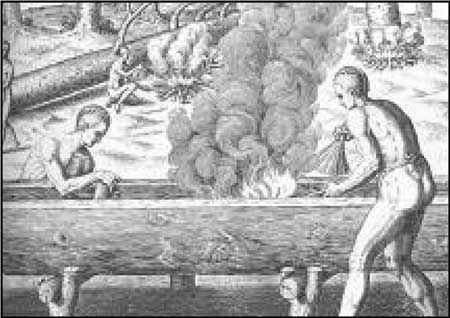
Detail of "The manner of making their boates,"
Theodor de Bry, 1590.
October 1705 — Acts of Assembly —
- No Negro, mulatto or Indian may bear any office, civil or military, or be in any place of public trust. If such a position is taken there will be a fine of 500 pounds of current money, and twenty pounds of like money for every month he continues. However, an Indian may hold such an office if commissioned from Her Majesty.234
- Definition of a mulatto: the child of an Indian, the child, grandchild or great grandchild of a Negro.235
- Indians may use adjacent county marks in marking their hogs. One third of the fine of 1000 pounds of tobacco of not possessing proper proof of mark now goes to the Queen and her heirs, and successors.236
- Larger reward for English in killing wolves than Indians. If the wolf is killed by pit or trap the reward is 300 pounds of tobacco, and 200 pounds of tobacco by other means. Indians are only to be paid 100 pounds of tobacco per wolf.237
- Indians, Negroes, mulattos, and non-Christians are not allowed to be witnesses in cases of law.238
- It is unlawful for the English to employ a Tuscarora, or other Indian, unless a slave or servant, to hunt or kill deer, or furnish them with guns and ammunition, on patent lands. Penalty is 1000 pounds of tobacco.239
- Any person finding an Indian hunting illegally on such lands is permitted to take the gun and ammunition into their own possession.340
- There is nothing in this act that should interfere with the hunting customs of the Pamunkey, Chickahominy or Eastern Shore Indians.241
- An act to prevent animosities, fears and misunderstandings between the tributary Indians and her majesty's subjects.242
- Indian chiefs are not to sell land allotted to them in the articles of peace on May 29, 1677.243
- An act to prevent non-Indians from buying or leasing Indian lands, bringing a fine of ten shillings for every acre of land so purchased, leased or occupied.244
- Exceptions to the above prohibition of acquiring Indian lands, the
following have been granted patents out of Pamunkey lands:
- George Shillings, 300 acres of land
- Michael Waldrop, 90 acres of land
- The heir of George Southerland, deceased, 200 acres.245
- No construction is to be made within three miles of any Indian
town, according to the articles of peace (originally Article IV
Treaty of Middle Plantation 1677.)246
Editor's Note: The reservation tribes, Pamunkey and Mattaponi, still considered the Treaty of 1677 a viable document. - If the English have already settled within three miles of an Indian town on the opposite side of a river, they may stay.247
- Tributary Indians are to be protected under English law as any Englishman.248
- Indians may obtain a license to go oystering, fishing, gathering items not useful to the English, such as Tuckahoe, cuttenemons, wild oats, rushes, puckoon, on English lands. If the Indians are hurt, the culprits will be punished as if the crime had been against an Englishman.249
- Indians may not bring guns and ammunition while foraging for oysters, fish, etc, and are not to stay any longer than the license permits.250
- All tributary Indian kings and queens are to notify the nearest militia officer of any strange Indian movements of war. The tributary Indians will be provided aid if needed against the strange Indians.251
- Tributary Indians are to march with the English against foreign Indians.252
- Free and open trade is now allowed at all times, with all Indians.253
- The sale of rum or brandy prohibited in Indian towns and on Indian lands. Penalty is ten shillings per quart of rum or brandy sold.254
- Grants of 14-year trading monopolies may be given to those discovering Indians towns and nations to the west, towards the Appalachian Mountains.255
- All acts limiting trade with Indians shall be repealed, except one act on the April 18, 1705, concerning the Nanzatico, and other Indians.256
Editor's Note:Despite the pressure of the oppressive legislation and of the 100 years of contact, the descendants of Virginia's original native inhabitants survived in the Commonwealth of Virginia, and are still here today.
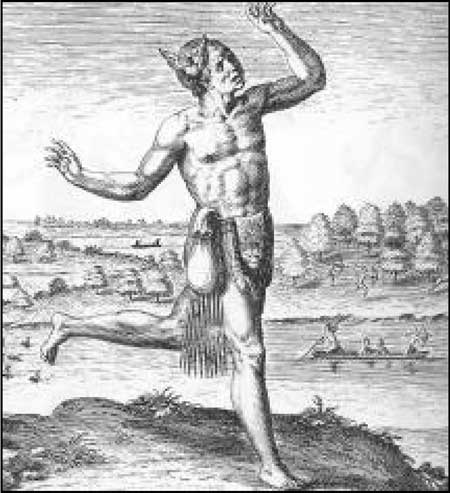
Detail of "The Coniuerer,"
Theodor de Bry, 1590.
End Notes
- (Abbot 1957:2)
- (Strachey [1612] 2001: 598)
- (Abbot 1957:2)
- (Abbot 1957:2; Rountree 1990: 31; Smith 1986a [1624]: 79)
- (Percy 1967:15-16; Abbot 1957:2-3)
- (Smith 2001a [1608]: 156-162; Smith 2001b [1624]: 239)
- (Smith 2001a [1608]: 162)
- (Smith 2001b [1624]: 260-2)
- (Smith 2001b [1624]: 268-273, 275-77)
- (Smith 2001b [1624]: 282; Smith 1986b: 184; Rountree 1990:47)
- (Abbot, 1957:5)
- (Haile 2001:62)
- (Smith 2001b: 334; Abbot 1957:5)
- (Tyler 1922:267-269; Brown 1890:I: 392)
- (Smith 1986b [1624]: 234; Tyler 1922:262)
- (Rountree 1990:55)
- (Hamor2001 [1615]: 820)
- (Abbot 1957:7)
- (Argall 2001 [1613]: 745-755; Abbot 1957:7; Smith 1986 [1624]: 243-244; Strachey, 1849 [1612]: 54; Townsend 2004)
- (Abbot 1957:7)
- (Dale 2001 [1614]: 845; Whitaker 2001 [1614]: 848; Rolfe 2001[1614]: 854; Rasmusse & Tilton 1994: 23)
- (Abbot 1957:7; Tyler 1946: 237; Smith 1986 [1624:245-246)
- (Abbot 1957:7; Smith 1986 [1624]: 258-261; Sams 1939:175)
- (Smith 1986 [1624]: 260-261)
- (Smith 1986 [1624]: 261-262; Rolfe 2001 [1617]: 888-889)
- (Abbot 1957:7-8)
- (Smith 1986 [1624]: 265)
- (McIlwaine 1905-1915:1619-1660:35; Brydon 1947:83)
- (Abbot 1957:9)
- (Abbot 1957:9-10; Smith 1986 [1624]: 294-295)
- (Abbot 1957:10; McIlwaine 1924:40, 120; Tyler 1907:438)
- (Henning 1823a: 123)
- (Henning 1823a: 126)
- (Henning 1823a: 127)
- (Stanard 1928: 176)
- (Abbot 1957:10)
- (Abbot 1957:11)
- (Abbot 1957:11)
- (Henning 1823a: 140)
- (Henning 1823a: 141)
- (Henning 1823a: 143)
- (Henning 1823a: 150)
- (Henning 1823a: 153)
- (Henning 1823a: 167)
- (Henning 1823a: 173)
- (Henning 1823a: 176)
- (Rountree 1990:81)
- (Henning 1823a: 192-193)
- (Henning 1823a: 193)
- (Henning 1823a: 198)
- (Henning 1823a: 219)
- (Henning 1823a: 219)
- (Nugent 1960-1979: I: 77, 150, 183; II: 211-212; McIlwaine 1924: 478). Research by Martha W. McCartney, see "Narrative History" in this publication.)
- (Henning 1823a: 227)
- (Henning 1823a: 227)
- (Henning 1823a: 255)
- (Henning 1823a: 255-256)
- (Rountree 1990: 84)
- (Henning 1823a: 287)
- (Henning 1823a: 287)
- (Henning 1823a: 290)
- (Henning 1823a: 292)
- (Henning 1823a: 293)
- (Henning 1823a: 300)
- (Henning 1823a: 315)
- (Henning 1823a: 317-318)
- (Henning 1823a: 319)
- (Beverley 1947: 62)
- (Force 1963:II:8: 13)
- (Henning 1823a: 323) Thus, later on in the Acts of the Assembly, the tribes that had signed the treaty of peace are often referred to as "Tributary Indians."
- (Henning 1823a: 323-324)
- (Henning 1823a: 324)
- (Henning 1823a: 324)
- (Henning 1823a: 325)
- (Henning 1823a: 325)
- (Henning 1823a: 325)
- (Henning 1823a: 325)
- (Henning 1823a: 325-326)
- (Henning 1823a: 326)
- (Henning 1823a: 326)
- (Henning 1823a: 324)
- (Henning 1823a: 328)
- (Henning 1823a: 328)
- (Henning 1823a: 328-329)
- (Henning 1823a: 333)
- (Henning 1823a: 333)
- (Henning 1823a: 333)
- (Henning 1823a: 337)
- (Henning 1823a: 348)
- (Henning 1823a: 380)
- (Henning 1823a: 382)
- (Henning 1823a: 382)
- (Henning 1823a: 389)
- (Henning 1823a: 391)
- (Henning 1823a: 391)
- (Henning 1823a: 395)
- (Henning 1823a: 396)
- (Henning 1823a: 396)
- (Henning 1823a: 396)
- (Henning 1823a: 401-402)
- (Henning 1823a: 402-403)
- (Henning 1823a: 410)
- (Henning 1823a: 410)
- (Henning 1823a: 410)
- (Henning 1823a: 415)
- (Henning 1823a: 441)
- (Henning 1823a: 454)
- (Henning 1823a: 455-456)
- (Henning 1823a: 456-457)
- (Henning 1823a: 457)
- (Henning 1823a: 467)
- (Henning 1823a: 467-468)
- (Henning 1823a: 470)
- (Henning 1823a: 470)
- (Henning 1823a: 471)
- (Henning 1823a: 481-482)
- (Henning 1823a: 515)
- (Henning 1823a: 518)
- (Henning 1823a: 521)
- (Henning 1823a: 525)
- (Henning 1823a: 541)
- (Henning 1823a: 547)
- (Henning 1823a: 546)
- (Henning 1969 [1823b]: 13-14)
- (Henning 1969 [1823b]: 14)
- (Henning 1969 [1823b]: 14-15)
- (Henning 1969 [1823b]: 15-16)
- (Henning 1969 [1823b]: 20)
- (Henning 1969 [1823b]: 34)
- (Henning 1969 [1823b]: 35)
- (Henning 1969 [1823b]: 36)
- (Henning 1969 [1823b]: 39)
- (Henning 1969 [1823b]: 39)
- (Henning 1969 [1823b]: 124)
- (Henning 1969 [1823b]: 138)
- (Henning 1969 [1823b]: 139)
- (Henning 1969 [1823b]: 139)
- (Henning 1969 [1823b]: 139)
- (Henning 1969 [1823b]: 140)
- (Henning 1969 [1823b]: 140)
- (Henning 1969 [1823b]: 141)
- (Henning 1969 [1823b]: 141)
- (Henning 1969 [1823b]: 141)
- (Henning 1969 [1823b]: 142)
- (Henning 1969 [1823b]: 142)
- (Henning 1969 [1823b]: 142)
- (Henning 1969 [1823b]: 143)
- (Henning 1969 [1823b]: 143)
- (Henning 1969 [1823b]: 143)
- (Henning 1969 [1823b]: 149)
- (Henning 1969 [1823b]: 150)
- (Henning 1969 [1823b]: 150)
- (Henning 1969 [1823b]: 150-151)
- (Henning 1969 [1823b]: 152)
- (Henning 1969 [1823b]: 152-153)
- (Henning 1969 [1823b]: 153)
- (Henning 1969 [1823b]: 153)
- (Henning 1969 [1823b]: 153-154)
- (Henning 1969 [1823b]: 154)
- (Henning 1969 [1823b]: 154)
- (Henning 1969 [1823b]: 155)
- (Henning 1969 [1823b]: 155)
- (Henning 1969 [1823b]: 155)
- (Henning 1969 [1823b]: 155)
- (Henning 1969 [1823b]: 155)
- (Henning 1969 [1823b]: 185)
- (Henning 1969 [1823b]: 193)
- (Henning 1969 [1823b]: 193)
- (Henning 1969 [1823b]: 193)
- (Henning 1969 [1823b]: 193)
- (Henning 1969 [1823b]: 194)
- (Henning 1969 [1823b]: 194)
- (Henning 1969 [1823b]: 194)
- (Henning 1969 [1823b]: 194)
- (Henning 1969 [1823b]: 194)
- (Henning 1969 [1823b]: 215)
- (Henning 1969 [1823b]: 219)
- (Henning 1969 [1823b]: 219)
- (Henning 1969 [1823b]: 219)
- (Henning 1969 [1823b]: 236)
- (Henning 1969 [1823b]: 237)
- (Henning 1969 [1823b]: 274-275)
- (Henning 1969 [1823b]: 275)
- (Henning 1969 [1823b]: 276)
- (Henning 1969 [1823b]: 280-281)
- (Henning 1969 [1823b]: 282)
- (Henning 1969 [1823b]: 283)
- (Henning 1969 [1823b]: 289)
- (Henning 1969 [1823b]: 316-317)
- (Henning 1969 [1823b]: 327)
- (Henning 1969 [1823b]: 327)
- (Henning 1969 [1823b]: 327)
- (Henning 1969 [1823b]: 331)
- (Henning 1969 [1823b]: 332)
- (Henning 1969 [1823b]: 336)
- (Henning 1969 [1823b]: 336)
- (Henning 1969 [1823b]: 337)
- (Rountree 1990:97)
- (Henning 1969 [1823b]: 341-342)
- (Henning 1969 [1823b]: 342)
- (Henning 1969 [1823b]: 343)
- (Henning 1969 [1823b]: 343)
- (Henning 1969 [1823b]: 343)
- (Henning 1969 [1823b]: 346)
- (Henning 1969 [1823b]: 350)
- (Henning 1969 [1823b]: 350)
- (Henning 1969 [1823b]: 351-352)
- (Rountree 1990:98)
- (Rountree 1990:99)
- (Rountree 1990:99)
- (Washburn, 1957:85)
- (Rountree 1990:100-101)
- (Henning 1969 [1823b]: 403)
- (Henning 1969 [1823b]: 403)
- (Henning 1969 [1823b]: 403)
- (Henning 1969 [1823b]: 404)
- (Henning 1969 [1823b]: 410)
- (Henning 1969 [1823b]: 440)
- (Henning 1969 [1823b]: 480)
- (Henning 1969 [1823b]: 490)
- (Henning 1823c: 69)
- (Henning 1823c: 69)
- (Henning 1823c: 69)
- (Henning 1823c: 83)
- (Henning 1823c: 84)
- (Henning 1823c: 84-85)
- (Henning 1823c: 86-87)
- (Henning 1823c: 98-99)
- (Henning 1823c: 100)
- (Henning 1823c: 100)
- (Henning 1823c: 109)
- (Henning 1823c: 115)
- (Henning 1823c: 141)
- (Henning 1823c: 251)
- (Henning 1823c: 252)
- (Henning 1823c: 278)
- (Henning 1823c: 282)
- (Henning 1823c: 298)
- (Henning 1823c: 343)
- (Henning 1823c: 343)
- (Henning 1823c: 343)
- (Henning 1823c: 464-465)
- (Henning 1823c: 465)
- (Henning 1823c: 465)
- (Henning 1823c: 466)
- (Henning 1823c: 466)
- (Henning 1823c: 466)
- (Henning 1823c: 467)
- (Henning 1823c: 467)
- (Henning 1823c: 467)
- (Henning 1823c: 467)
- (Henning 1823c: 468)
- (Henning 1823c: 468)
- (Henning 1823c: 468)
- (Henning 1823c: 468)
- (Henning 1823c: 469)
Bibliography
Abbot, William W.
1957 A Virginia Chronology 1958-1783. Williamsburg, Virginia: Virginia 350th Anniversary Celebration Corporation.
Argall, Samuel
2001 [1613] Letter to Don Alonso de Velasco, 28 May 1613 in Jamestown Narratives, Eyewitness Accounts of the Virginia Colony, The First Decade: 1607-1617, ed. Edward Wright Haile, first printing in 1998. Champlain, Virginia: RoundHouse.
Beverley, Robert
1947 [1705] The History and Present State of Virginia, in Four Parts, by a Native and Inhabitant of the Place, ed. Louis B. Wright, frist printing in 1705, London: R. Parker. Chapel Hill: University of North Carolina Press.
Brown, Alexander
1890 The Genesis of the United States. 2 vols. Houghton, Mifflin and Company, Boston and New York. Reprint, Heritage Books, Inc., Bowie, Maryland, 1994.
Brydon, George M.
1947 Virginia's Mother Church. Whittet and Shepperson, Richmond, Virginia.
Dale, Sir Thomas
2001 [1614] Letter to Mr. D. M. in London in Jamestown Narratives, Eyewitness Accounts of the Virginia Colony, The First Decade: 1607-1617, ed. Edward Wright Haile, first printing in 1998. Champlain, Virginia: RoundHouse.
Haile, Edward Wright Haile, ed.
2001 Jamestown Narratives, Eyewitness Accounts of the Virginia Colony, The First Decade: 1607-1617,first printing in 1998. Champlain, Virginia: RoundHouse.
Hamor, Ralph
2001 [1615] "A True Dicourse" in Jamestown Narratives, Eyewitness Accounts of the Virginia Colony, The First Decade: 1607-1617, ed. Edward Wright Haile, first printing in 1998. Champlain, Virginia: RoundHouse.
Force, Peter, comp.
1963 [1836-46] Tracts and Other Papers Relating Principally to the Origin, Settlement, and Progress of the Colonies in North America, from the Discovery of the Country to the Year 1776. Washington: Printed by P. Force, 4 vols.
Hening, William Waller
1823a The Statutes at Large; Being a Collection of All the Laws of Virginia from the First Session of the Legislature, in the year 1619, Vol. I. New York: R. & W. & G. Bartow.
1969 [1823b] Statutes at Large; Being a Collection of All the Laws of Virginia from the First Session of the Legislature, in the year 1619, Vol. II. Reprint of 1823 New York: R. & W. & G. Bartow. Charlottesville: University Press of Virginia.
1823c The Statutes at Large; Being a Collection of All the Laws of Virginia from the First Session of the Legislature, in the year 1619, Vol. III. Philadelphia: Thomas Desilver.
Kingsbury, Susan Myra, ed.
1906-1935 The Records of the Virginia Company of London. Washington: Library of Congress. 4 vols.
McIlwaine, H. R., et al, eds.
1905-1915 Journals of the House of Burgesses, 1619-1776. 13 Vols. Virginia State Library, Richmond, Virginia.
McIlwaine, H. R., ed.
1924 Minutes of Council and General Court of Colonial Virginia. The Library Board, Richmond, Virginia. Reprinted 1934, 1979.
Nugent, Nell Marion
1666-1979 Cavaliers and Pioneers: Abstracts of Virginia Land Patents and Grants. Vol. 2: 1666-1695; Vol. 3: 1695-1732. Richmond: Virginia State Library], 1977-1979.
Percy, George
1967 [1006] Observations Gathered out of "A Discourse of the Plantation of the Southern Colony in Virginia by the English, 1606, edited by David B. Quinn. The University Press of Virginia: Charlottesville.
Rasmussen, William M. S., and Robert Steven Tilton.
1994 Pocahontas: Her Life and Legend. Virginia Historical Society: Richmond.
Rolfe, John
2001 [1614] Letter to Sandys, 8 June 1617 in Jamestown Narratives, Eyewitness Accounts of the Virginia Colony, The First Decade: 1607-1617, ed. Edward Wright Haile, first printing in 1998. Champlain, Virginia: RoundHouse.Rolfe, John.
2001 [1614] Letter to Sir Thomas Dale in Jamestown Narratives, Eyewitness Accounts of the Virginia Colony, The First Decade: 1607-1617, ed. Edward Wright Haile, first printing in 1998. Champlain, Virginia: RoundHouse.
Sams, Conway Whittle,
1939 The Conquest of Virginia, The Third Attempt 1610-1624. New York: G.P. Putman's Sons.
Strachey, William
2001 [1612] "The History of Travel into Virginia Britannia" in Jamestown Narratives, Eyewitness Accounts of the Virginia Colony, The First Decade: 1607-1617, ed. Edward Wright Haile ,first printing in 1998. Champlain, Virginia: RoundHouse.
1849 [1612] The Historie of Travaiel into Virginia Britannia. Facsimile of The Hakluyt Society. London 1849 edition. Elibron Classics.
Smith, John
2001a [1608] "A True Relation" in Jamestown Narratives, Eyewitness Accounts of the Virginia Colony, The First Decade: 1607-1617, ed. Edward Wright Haile, first printing in 1998. Champlain, Virginia: RoundHouse.
2001b [1624] "The Genaral History, 3rd Book" in Jamestown Narratives, Eyewitness Accounts of the Virginia Colony, The First Decade: 1607-1617, ed. Edward Wright Haile, first printing in 1998. Champlain, Virginia: RoundHouse.
1986a [1624] "A True Relation" in The Complete Works of Captain John Smith (1580-1631) Volume 1, ed. Philip L. Barbour. Chapel Hill, N.C.: The University of North Carolina Press .
1986b [1624] "The Generall Historie" in The Complete Works of Captain John Smith (1580-1631) Volume 2, ed. Philip L. Barbour. Chapel Hill, N.C.: The University of North Carolina Press.
Stanard, Mary Newton
1928 The Story of Virginia's First Century. Philadelphia and London: J.B. Lippincott Company.
Rountree, Helen C.
1990 Pocahontas's People, The Powhatan Indians of Virginia Through Four Centuries. Norman and London: University of Oklahoma Press.
Townsend, Camilla
2004 Pocahontas and the Powhatan Dilemma. New York: Hill and Wang.
Tyler, Lyon G., ed.
1922 "A Trewe Relacyon." Tyler's Historical Quarterly 3:259-282.
1907 Narratives of Early Virginia. Barnes and Noble, New York, New York.
Washburn, Wilcomb E.
1957 Governor and the Rebel: A History of Bacon's Rebellion in Virginia. W.W. Norton, New York.
| <<< Previous | <<< Contents >>> | Next >>> |
jame/moretti-langholtz/chap7.htm
Last Updated: 22-Nov-2006